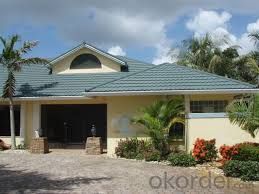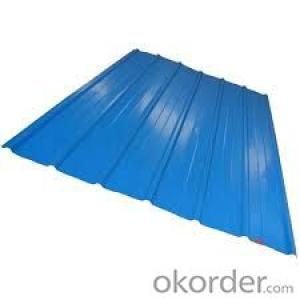PPGI/Pre-Painted Color Coated Galvanized Steel Coil/PPGI/China PPGI for Roof Sheet
- Loading Port:
- China main port
- Payment Terms:
- TT OR LC
- Min Order Qty:
- 25 m.t.
- Supply Capability:
- 1000 m.t./month
OKorder Service Pledge
OKorder Financial Service
You Might Also Like
Product Description
Product Description
| PRODUCT SPECIFICATION |
Commodity | Prepainted galvanized steel coil |
Base Metal |
|
| 0.16 TO 1.00 mm |
Width | 600 TO 1500 mm |
Coil ID | 508 / 610 mm |
Type | coil/sheet/strips |
|
|
| Soft, medium,full hard |
Zinc Coating | Z 40-275 gsm, AZ 40-180 gsm or as customer requirements |
Types of top coating |
|
| As per RAL shades/customer requirements. |
Surface Finishes | Glossy and Matte |
Price: | US $600-800 / Metric Ton |
Slits | 37mm and above |
Standards | AISI, ASTM, BS, DIN, GB, JIS |
Transport | By bulk or container |
Packing | Standard packing or at buyer's requirement |
Applications:
Pre-painted steel metal products are used in a vast array of applications including:
1.construction industry
2. household appliances
3.automotive
4.industrial applications
5.packaging


FAQ
What is the validity of your quotation?
Normally 2 days.
- Q:With the Reduced weight of steel,wouldn't the projectile be at a much higher velocity when fired causing more damage?I mean l couldn't steel be worked to seal the bore,not damage the rifling and still cheap enough to mass produce,and be light enough to carry much more ammo.
- Okay one side note before going into the main issue. Steel is really really hard on rifle barrels. Okay, so the most common lead 9mm bullet weighs 124 grains. If all that was wanted was higher velocity, you could switch to a 115 grain bullet (which some people do), or even a 90 grain bullet if you are a reloader. (You see 90 grain bullets for 380 acp ammo, that same bullet could be reloaded onto a 9mm cartridge) But velocity alone doesn't give power. That's why a 115 grain 9mm bullet going at it's standard velocity does less damage than a 45 acp's 230 grain bullet going at it's standard velocity, because it weights twice as much and yet is going only a little bit slower But now go out to your front yard and grab a ping-pong ball and a rock about the same size. Throw them both as hard as you can. The ping-pong ball while lighter didn't go very far did it. See, the ratio of surface area to overall weight of ping-pong ball is very high, so air resistance works on it a LOT. And that is what makes lead so great for projectiles. It is dense so you have a very small surface area per unit of weight meaning that a steel bullet may beat lead in initial velocity but just 50 feet out the lead bullet would be going pretty much the same speed and at 100 yards out the steel would be dramatically slower. Note this is the same reason why 'secret sniper ice bullets' would never work even if you could get it to not melt...it's just too light. Ever hear of tanks and airplanes firing DU ammo? That stands for Depleted Uranium, it is something that is even more dense than lead which is why it makes an even better bullet than lead
- Q:Why cold rolled stainless steel sheet is lower than cold rolled stainless steel coil?
- 304 stainless steel coil 2.0*1219*C spot price 18 thousand and 100 / ton, general tolerance at about 1.8mm.Coil price * actual thickness / reference thickness = flat price1.81*1.8/2=16.29
- Q:and what type of metal is steel?
- From the steel store. ;) Steel is an alloy consisting mostly of iron, with a carbon content between 0.2% and 2.14% by weight (C:110–10Fe), depending on grade. Carbon is the most cost-effective alloying material for iron, but various other alloying elements are used such as manganese, chromium, vanadium, and tungsten.
- Q:Where can a find a steel scrubber. Its great to clean cooking vessels. Would be great if someone gives me an idea. I did not find it at CVS, but was in a hurry, will try again tomorrow.
- I posted this earlier to a similar question... Really burnt on gunk in the bottom like milk or blackened food can easily be cleaned out of stainless steel pots and pans by sprinkling baking soda in the bottom, covering with vinegar, let simmer with a little water for 5 min. Let cool, scrub out with a vinyl scrubby. or I use a lot of stainless steel for cooking and over the years have found a very inexpensive solution to cleaning them especially the ones with burnt food stuck at the bottom. I use Used fabric softner sheets (sheets that i have already used in the dryer for my clothes) and have them soak in water in the dirty pan overnight. Next morning i use the same sheet as scrubber to clean the pan and all the burnt food comes off easily leaving a new look to the pan. Try it this works.
- Q:i was giving this old knive. the knife part is stainless steel and has a couple rust spots but im not sure that the handle is (i think stainless) but it has this un smooth surface i dont think its rust because its not brown. would rubbing alcohol help clean it?
- Your answers are all good but I would mention that we have a set of Sabtier chef knifes that were expensive these look to be stainless but are not quite as I think that marine grade stainless does not make the best cutting edge and my guess is that your knife would contain a greater amount of carbon better cutting edge but not so stainless. As a carpenter that has to sharpen cutting tools I add that I have never had a chisel or plane blade that was made of stainless steel and the best edges I obtain are with vintage tools. Bar Keepers friend is great as is 00 grade wire wool but do not put your knife through the dishwasher as the cleaning tabs will pit the surface of your knife.
- Q:What are the challenges in coil recoiling for high-strength steel?
- One of the main challenges in coil recoiling for high-strength steel is the control and management of residual stresses. High-strength steel has a tendency to retain significant levels of residual stresses, which can lead to coil distortion or springback during recoiling. This requires careful process optimization and control to minimize these effects. Additionally, the high strength of the steel can make it more susceptible to cracking or damage during recoiling, necessitating precise handling techniques and equipment. Overall, the challenges lie in achieving uniform coil geometry, minimizing residual stresses, and avoiding any potential damage to the high-strength steel during the recoiling process.
- Q:How are steel coils used in the production of metal buildings?
- Steel coils are used in the production of metal buildings as they serve as the primary material for constructing the building's structural components, such as beams, columns, and trusses. These coils are unrolled and cut into specific lengths, which are then formed, welded, and assembled to create the framework of the metal building. The strength and durability of the steel coils ensure the longevity and stability of the structure, making them an essential component in the construction process.
- Q:What are the common coil coating materials?
- The common coil coating materials include polyester, polyurethane, polyvinylidene fluoride (PVDF), and silicone-modified polyester (SMP).
- Q:What are the different methods of steel coil surface cleaning?
- There are several methods of steel coil surface cleaning, including mechanical cleaning, chemical cleaning, and high-pressure water cleaning. Mechanical cleaning involves using abrasive materials or brushes to physically remove dirt, rust, and other contaminants from the surface. Chemical cleaning uses various chemicals or solvents to dissolve or loosen the contaminants, making them easier to remove. High-pressure water cleaning involves spraying water at a high pressure to dislodge and wash away the dirt and debris. These methods can be used individually or in combination, depending on the level of cleanliness required and the specific condition of the steel coil.
- Q:What are the applications of steel coils in automotive manufacturing?
- Due to their unique properties and characteristics, steel coils find a wide range of applications in automotive manufacturing. They offer numerous benefits and contribute significantly to the overall performance, safety, and reliability of automobiles. One primary application of steel coils in automotive manufacturing is their use in the production of body panels. These coils are employed to create the outer body structure of vehicles, including doors, hoods, fenders, and roofs. The exceptional strength and durability of steel make it an ideal material for these components, providing protection against impacts and enhancing the overall structural integrity of the vehicle. Automotive chassis and frames also rely on steel coils during their manufacturing process. The robust and rigid nature of steel makes it an excellent choice for these critical components, enabling them to withstand heavy loads and provide stability to the vehicle. Steel coils ensure that the chassis and frames possess the necessary strength and stiffness to support the weight of the vehicle and endure the forces experienced during driving. Moreover, steel coils play a crucial role in the production of various suspension and steering components, such as springs, stabilizer bars, and control arms. These parts require high strength and resistance to fatigue, as they constantly face stress and vibrations. Steel coils provide the required toughness and flexibility to these components, ensuring smooth and controlled vehicle handling. Furthermore, steel coils find application in the manufacturing of engine parts and exhaust systems. The high-temperature resistance and corrosion resistance of steel make it an ideal material for these purposes. Steel coils are shaped into various forms, including tubes and pipes, to create exhaust manifolds, catalytic converters, and mufflers. They play a significant role in enhancing the performance and efficiency of the engine while reducing harmful emissions. In summary, steel coils are indispensable in automotive manufacturing due to their strength, durability, and versatility. They are utilized in the production of body panels, chassis, suspension components, engine parts, and exhaust systems. The incorporation of steel coils in these applications ensures the safety, reliability, and optimal performance of vehicles, making them an essential material in the automotive industry.
1. Manufacturer Overview |
|
|---|---|
| Location | |
| Year Established | |
| Annual Output Value | |
| Main Markets | |
| Company Certifications | |
2. Manufacturer Certificates |
|
|---|---|
| a) Certification Name | |
| Range | |
| Reference | |
| Validity Period | |
3. Manufacturer Capability |
|
|---|---|
| a)Trade Capacity | |
| Nearest Port | |
| Export Percentage | |
| No.of Employees in Trade Department | |
| Language Spoken: | |
| b)Factory Information | |
| Factory Size: | |
| No. of Production Lines | |
| Contract Manufacturing | |
| Product Price Range | |
Send your message to us
PPGI/Pre-Painted Color Coated Galvanized Steel Coil/PPGI/China PPGI for Roof Sheet
- Loading Port:
- China main port
- Payment Terms:
- TT OR LC
- Min Order Qty:
- 25 m.t.
- Supply Capability:
- 1000 m.t./month
OKorder Service Pledge
OKorder Financial Service
Similar products
New products
Hot products
Related keywords





























